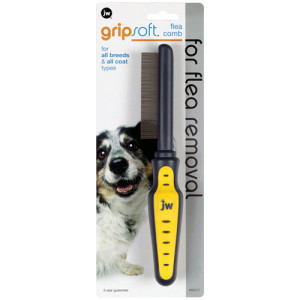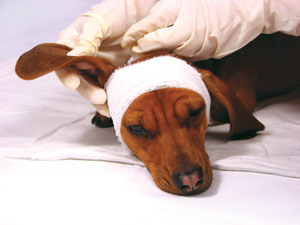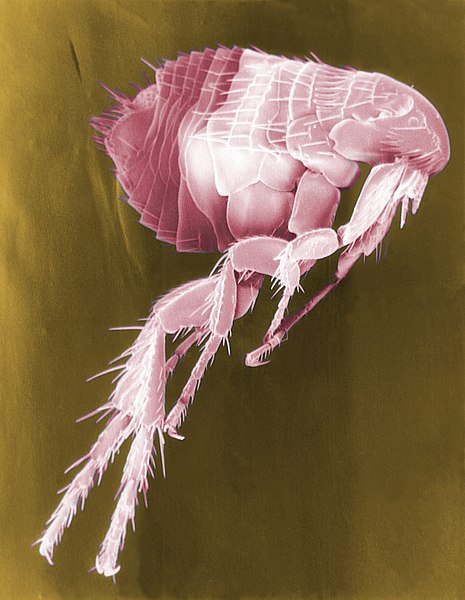Parasites can afflict pets any time of the year, however during the spring and summer months, they tend to be more prevalent. Our pets spend a lot more time outside when the weather is warm, and parasites breed more readily. Even if your pets spend all or most of their time indoors, it is possible for parasites to find them whether carried in on our clothes or by crawling through our screen doors. Here are some common parasites to look out for and ways to combat them this summer. Read More »
Category Archives: Fleas & Ticks
Feed SubscriptionJump Into Spring With These Flea Prevention Tips
Hi Pet Blog Readers,
We’ve made it to the middle of the week. If you are having trouble battling Hump Day, we’ve got a great guest blog from Hartz that should help you get through the day and also gain some valuable knowledge on flea prevention. Fleas can be troublesome and expensive to treat, so it’s a good idea to get ahead of the game and try to stop them before they start. Hartz has some great information and tips that will help. If you have any questions or comments, please let us know in the comments section below. Thanks!
_________
The weather is finally turning and that means it’s a great time to think about springtime flea prevention for your dog or cat. It may come as a surprise, but fleas are active year-round, which means those pests that survive the winter are just as ready for the spring as your four-legged friend.
Before your dog or cat stands at the door, ready to get back to enjoying the warm air and fresh grass of the outside world, there are a few steps you need to take to ensure that your pet is safe from those bloodsucking pests.
Examine your pet

It is not uncommon for dogs or cats to pick up fleas during the winter, so you should inspect your furry friend for any signs of fleas or their eggs. Use a fine-toothed flea comb to check your pet for flea droppings, which are small black or dark brown specks that generally clump together at the base of your pet’s fur, or tiny white dots. If your pet has this residue clinging to his coat, then he has been infested with fleas and will need treatment before venturing outside. Fortunately, there are a few ways to instantly eliminate fleas. Your pet’s health care provider can prescribe a pill that will kill all the adult fleas present on your pet within 24 hours. In addition to medication, a bath using special flea shampoo can clean your dog or cat of any flea eggs or larvae.
Consider your pet’s lifestyle
There are so many flea-repelling products on the market that choosing just one can overwhelm pet owners. To get a better idea of what type of flea prevention care your furry friend needs, you need to take into account his outdoor surroundings and activities. For example: Does your dog like to explore wooden areas? Does your cat have a habit of climbing trees? Are there streams and other sources of water nearby? Do you and your pet live by the beach? All of these factors can increase your four-legged friend’s likelihood of contracting fleas, so you’ll need to answer these questions to better determine which flea prevention treatment is right for your pet.
Weigh the options
 Once you’ve considered your pet’s lifestyle, it’s time to choose the best flea treatment for your furry friend. Most pet owners narrow the options down to the flea collar versus flea drops. Flea collars are worn around the neck and work in two ways: some emit a gas that repels fleas, while others release medication that’s absorbed into your dog’s or cat’s subcutaneous fat layer. Once absorbed, it repels and eliminates adult fleas and larvae from infesting your animal’s coat. Flea collars can typically work for several months, with some newer designs lasting for up to eight months, making it a great option for pets that are always on the go or living in high-risk areas. Meanwhile, flea drops are a topical treatment that is applied between the shoulder blades of your dog or cat. These treatments attack fleas and their eggs, immobilizing and eventually eliminating them. However, flea drops only last for one month, so they require diligence and consistency from pet owners.
Once you’ve considered your pet’s lifestyle, it’s time to choose the best flea treatment for your furry friend. Most pet owners narrow the options down to the flea collar versus flea drops. Flea collars are worn around the neck and work in two ways: some emit a gas that repels fleas, while others release medication that’s absorbed into your dog’s or cat’s subcutaneous fat layer. Once absorbed, it repels and eliminates adult fleas and larvae from infesting your animal’s coat. Flea collars can typically work for several months, with some newer designs lasting for up to eight months, making it a great option for pets that are always on the go or living in high-risk areas. Meanwhile, flea drops are a topical treatment that is applied between the shoulder blades of your dog or cat. These treatments attack fleas and their eggs, immobilizing and eventually eliminating them. However, flea drops only last for one month, so they require diligence and consistency from pet owners.
Don’t forget the indoors
Flea prevention isn’t just for the outdoors. Fleas can hide in the nooks and crannies of your home, while flea eggs can lie dormant in your carpets or upholstered furniture for months on end. To ensure that your four-legged friend is safe from fleas, vacuum your home at least once a week, including your furniture, tough-to-reach corners and any bedding your pet touches. Studies have shown that vacuuming eliminates 96 percent of adult fleas and nearly 100 percent of young fleas.
How to treat and prevent flea allergy dermatitis in dogs
 Many people in the northeast have had a rough time with fleas this summer. A combination of a mild winter in 2012 and a humid summer have created the perfect storm for these tough bugs to thrive. The battle against flea infestations doesn’t end with the cooler weather of fall. In many areas, even here in the northeast, fleas are active until the dead of winter and can even continue living in your home during the cold winter months. Don’t let your guard down, the battle against fleas is never over.
Many people in the northeast have had a rough time with fleas this summer. A combination of a mild winter in 2012 and a humid summer have created the perfect storm for these tough bugs to thrive. The battle against flea infestations doesn’t end with the cooler weather of fall. In many areas, even here in the northeast, fleas are active until the dead of winter and can even continue living in your home during the cold winter months. Don’t let your guard down, the battle against fleas is never over.
 I use a topical “spot on” flea preventative on my dogs every month. If you want to get specific about it, I use Sentry Fiproguard Max (it’s a less-expensive generic brand of Frontline Plus). However, these preventative measures weren’t enough for me this year.
I use a topical “spot on” flea preventative on my dogs every month. If you want to get specific about it, I use Sentry Fiproguard Max (it’s a less-expensive generic brand of Frontline Plus). However, these preventative measures weren’t enough for me this year.
Read More »
Dealing with Hot Spots – Pet Health
Has your pet ever experienced hot spots? Hot spots, otherwise known as acute moist dermatitis (AMD), are red, oozing lesions that may form on your pet’s skin…they’re kind of wet and scabby. The patches of irritation may start out as an unnoticeable bite, sting, pustule or other minor skin problem, but your dog’s natural instinct to lick, chew and scratch the area leads to a larger, more visible patch which progresses from a minor bump to hair loss, staining, flaking and possibly infection or permanent scars. Hot spots can can be a problem any time of year, and for any dog, and if you’ve ever had a pet develop hot spots you can guess from seeing them how aggrivating and painful they must be to experience. Let’s discuss hot spots and how you can prevent, heal and otherwise deal with AMD.
What Causes Hot Spots?
 Hot Spots have lots of causes, and they rear their ugly heads quickly, and sometimes without any warning. Some of the most common causes are flea or insect bites. Allergens or other irritants that come in contact with your pet’s skin are also a common cause. Small scratches or wounds can also begin an outbreak, particularly as your dog instinctively licks the area. Dogs that experience stress, anxiety or boredom can also scratch or chew, simply to occupy their minds. But the underlying blame falls on bacteria that infest these minor skin breaks, further inflaming an already irritated area. Any dog can develop a hot spot, but dogs who are not washed and brushed regularly, those with sensitive skin, and those with thick, long fur can be more prone to developing hot spots. Read More »
Hot Spots have lots of causes, and they rear their ugly heads quickly, and sometimes without any warning. Some of the most common causes are flea or insect bites. Allergens or other irritants that come in contact with your pet’s skin are also a common cause. Small scratches or wounds can also begin an outbreak, particularly as your dog instinctively licks the area. Dogs that experience stress, anxiety or boredom can also scratch or chew, simply to occupy their minds. But the underlying blame falls on bacteria that infest these minor skin breaks, further inflaming an already irritated area. Any dog can develop a hot spot, but dogs who are not washed and brushed regularly, those with sensitive skin, and those with thick, long fur can be more prone to developing hot spots. Read More »
Home Remedies for Minor Pet Ailments
 You’ve all heard the old addage that an apple a day keeps the doctor away. Maybe you eat garlic to kill a cold, or gargle salt water to heal a sore throat. We’ve all tried home remedies to cure a minor ailment. I think I may have tried them all! There are also home remedies available for us to help our pets. Here are some simple home remedies you can use to help your pet cope with minor ailments like for skin irritations, coat issues, and digestive upset in the comfort of your own home.
You’ve all heard the old addage that an apple a day keeps the doctor away. Maybe you eat garlic to kill a cold, or gargle salt water to heal a sore throat. We’ve all tried home remedies to cure a minor ailment. I think I may have tried them all! There are also home remedies available for us to help our pets. Here are some simple home remedies you can use to help your pet cope with minor ailments like for skin irritations, coat issues, and digestive upset in the comfort of your own home.
Caution: Use your best judgment, if your pet is bleeding, having difficulty walking, is lethargic, or has been vomiting/experiencing diarrhea for a prolonged period of time get your pet to the vet right away! These remedies are only intended for minor irritations. Read More »
Warm Weather Worries – Common Pet Parasites and Pests
 Parasites can afflict pets any time of the year, however during the spring and summer months, they tend to be more prevalent. Our pets spend a lot more time outside when the weather is warm, and parasites breed more readily. Even if your pets spend all or most of their time indoors, it is possible for parasites to find them whether carried in on our clothes or by crawling through our screen doors. Here are some common parasites to look out for and ways to combat them this summer. Read More »
Parasites can afflict pets any time of the year, however during the spring and summer months, they tend to be more prevalent. Our pets spend a lot more time outside when the weather is warm, and parasites breed more readily. Even if your pets spend all or most of their time indoors, it is possible for parasites to find them whether carried in on our clothes or by crawling through our screen doors. Here are some common parasites to look out for and ways to combat them this summer. Read More »
Flea and Tick Treatments – Use Caution
Spring has (finally) arrived and fleas have returned along with it. You may have heard recently in the news that there has been an increase of the number of adverse reactions to over-the-counter “spot on” flea and tick treatments. The EPA has taken notice and they are starting to take action.
What was the problem?
Flea and tick preventative maintenance is an important part of your pet’s health.  It’s important to safe guard your pet against pests that can carry deadly diseases like Lyme disease. However, it is also important to remember that these medications are still pesticides and should be handled with care. The EPA found that some dogs, usually smaller breeds, and cats could have potentially harmful reactions to spot-on flea and tick treatments. Reactions ranged from skin irritation to more severe medical conditions like seizures, and in a few cases, even death. Most of the reactions were caused by “overdose” or using too much of the topical product for the size of the pet. Reactions in cats were typically the result of exposure to a dog- specific formula, either accidentally or through incorrect usage of the product. While the EPA mainly investigated “spot-on” flea and tick treatments, they recommend using caution with all flea and tick products, including shampoos, collars, and sprays/powders.
It’s important to safe guard your pet against pests that can carry deadly diseases like Lyme disease. However, it is also important to remember that these medications are still pesticides and should be handled with care. The EPA found that some dogs, usually smaller breeds, and cats could have potentially harmful reactions to spot-on flea and tick treatments. Reactions ranged from skin irritation to more severe medical conditions like seizures, and in a few cases, even death. Most of the reactions were caused by “overdose” or using too much of the topical product for the size of the pet. Reactions in cats were typically the result of exposure to a dog- specific formula, either accidentally or through incorrect usage of the product. While the EPA mainly investigated “spot-on” flea and tick treatments, they recommend using caution with all flea and tick products, including shampoos, collars, and sprays/powders.
What are they going to do to solve it?
To reduce the number of reactions and eliminate misuse of the products, the EPA is now enforcing tighter restrictions on ingredients and pursuing labeling changes and guidelines. The most significant change they are suggesting is making more dose sizes available. Instead of 3 different sizes of the medication, there might be 5, introducing a narrower pet weight range per medication. They are also pushing to make the packaging vastly different on dog and cat products to eliminate confusion, and other labeling changes to eliminate confusion. The EPA is also going to start requiring clinical trials and observations on new formulas.
What can I do to ensure my pets’ safety?
Consult your vet. Find out which brand they recommend for your pets and situation. This is extremely  important if your pet is weak, elderly, sick, on medication, pregnant or nursing. You should also carefully read all instructions before applying flea and tick treatments, especially if you have not used the product before. When purchasing a flea and tick treatments be sure to know the current weight of your pets to select the correct product.
important if your pet is weak, elderly, sick, on medication, pregnant or nursing. You should also carefully read all instructions before applying flea and tick treatments, especially if you have not used the product before. When purchasing a flea and tick treatments be sure to know the current weight of your pets to select the correct product.
There are some precautions you can take to help control your pet’s exposure to fleas and ticks, too. Vacuuming regularly and washing both you and your pet’s bedding regularly can help to prevent populations from establishing in your house. You can alter your yard to be less tick-friendly and discourage deer from visiting.
See the EPA’s article on taking care of fleas and ticks on your pet for more information on safety and what to do if you suspect your pet is having a reaction to flea and tick medication.
 That Pet Blog That Pet Place Pet Blog
That Pet Blog That Pet Place Pet Blog
